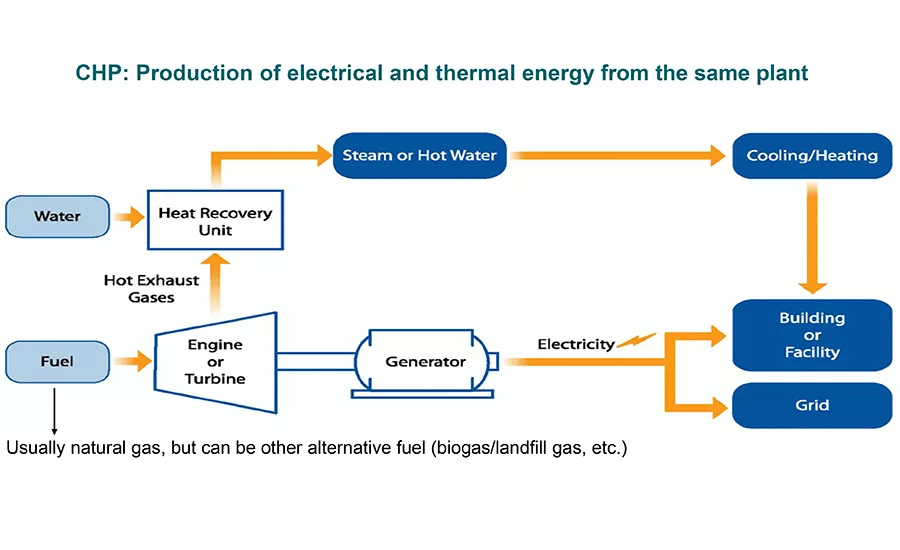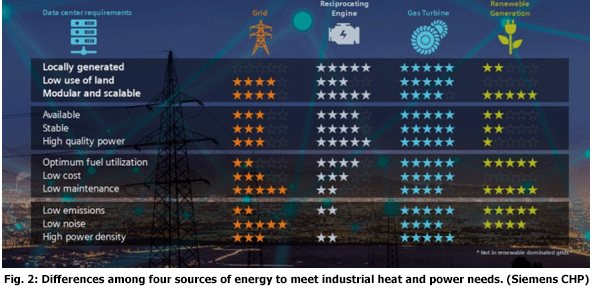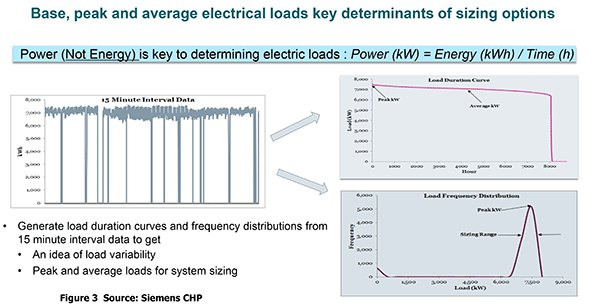Energy
Combined heat and power cogeneration can ensure consistency and save energy
Gas-fired turbine engines are a relatively low-maintenance investment that can pay for themselves

In food and beverage production, consistency—in quality, output, costs, regulatory compliance and sustainability—is everything. Variability in any of these areas can bedevil process engineers and, if inadequately mitigated or remediated, can torpedo a producer’s bottom-line.
Of course, variability can come from many sources, but two in particular are process steam and power. Reliability and availability of these resources can be critical factors in cost-efficient production. But for many plants today, the disruptions and rising costs of their process steam and power sources can put operation and profits at risk.
For example, many plants depend on aging boilers for their thermal requirements, so the older their boilers get, the less efficient they become and the greater the risk of breakdowns—not to mention the costs of increased maintenance and spare parts. Then, if production disruptions occur as a result of boiler downtime, batch runs can be ruined with costs that can potentially be astronomical. In addition, time lost to an unplanned clean-in-place (CIP) cycle can push out production schedules, compromising customer delivery commitments.
Old boilers also have a very low fuel utilization, which results in high CO2 emission. And, on top of this, they emit large amounts of pollutants such as NOx.
On the power side, food and beverage producers can be subject to variable utility ratchet charges during daily and seasonal peak-use periods. What’s more, utilities are seeing greater variability in their own operations, mostly from adding renewable sources, such as solar and wind, to their generation mix. Not to ignore the fact that more and more severe weather has had a negative impact on the bulk power grid’s reliability and availability.
Solving these variability challenges requires that utilities modernize their grids. But doing so will need major capital investments that they’ll certainly pass along to rate payers, including food and beverage producers who are among their largest customers.
For example, even though the cost of energy itself may be relatively inexpensive today, the capital costs incurred by utilities to upgrade their grids are commonly passed on to their largest customers as a fixed, monthly, capital recovery fee. These fees have—and will likely continue—to increase substantially as utilities across the U.S. adapt to incorporate more and more intermittent, renewable resources.
CHP: Proven technology with potential for much greater adoption
For these reasons, food and beverage plant operators who have not yet invested in combined heat and power (CHP) cogeneration should consider the benefits of upgrading to today’s advanced, flexible-fuel CHP technology. By becoming self-reliant in meeting their thermal energy-and-power needs, food processors can minimize their exposure to these escalating future charge-backs as well as lost production time due to grid outages. This can make an even more compelling business case for deploying CHP in their operations in addition to the many benefits discussed in this section.
In fact, CHP is already widely deployed in the U.S. food and beverage industry. According to the U.S. Department of Energy (DOE), the industry’s plants currently operate a combined 5,000 MW of CHP on-site generation capacity. But that’s just 25 percent of what the DOE estimates the industry’s total potential capacity of 20,000 MW for CHP deployment to be.
This data implies that CHP technology is providing proven benefits and competitive advantages for the early adopters among food and beverage plant operators, yet many more are still using aging boiler systems and relying on utility power.
Early adopters of CHP have not only gained greater control, certainty, and consistency over their thermal and power resources and associated cost but also much more efficiency, simplified operations, and as an added bonus, lower greenhouse gas (GHG) emissions. Siemens own data has shown that CHP’s cost benefits alone can pay for gas turbine systems in five to seven years with a 15-year internal rate of return as high as 23 percent.
Figure 1 (above) shows a common CHP configuration. Often fueled by natural gas, an industrial gas turbine or reciprocating engine drives a generator scaled for a particular plant’s operational requirements to power its equipment, lights, HVAC, and refrigeration. At the same time, an integrated heat recovery unit combines the turbine’s or motor’s thermal energy with water to produce steam or hot water for cooling and heating applications.
Note that gas turbines, such as the ones made by Siemens, have an added advantage of fuel flexibility, especially biofuels. For example, many food processing plants generate biomass and biofuels as production byproducts, so CHP facilities can be engineered to make use of those fuels. Hydrogen produced as an off-gas or by electrolysis—produced by renewable power—can also be used as gas turbine fuel (for some types even 100 percent), which offers high potential for the future.
Gas turbines have other advantages over stationary reciprocating internal combustion engines (RICEs) that are often employed by the food and beverage industry. Advantages include higher power density; lower maintenance costs; better H2 fuel-handling capability; and lower GHG, pollutants, and noise emissions. Figure 2 (below) compares the differences among four primary sources of energy to meet industrial heat and power needs.

Considerations for engineering a cost-effective CHP facility
To qualify a plant for a potential CHP cogeneration facility, three sets of criteria must be considered: thermal and electrical loads; electricity and fuel costs; and site-specific conditions. To best determine these, plant engineers will find that it helps to engage expert guidance from sources experienced in CHP planning, engineering, deployments, and operations.
Electrical loads, for example, are key determinants of CHP system sizing options. Base, peak, and average electrical loads must be evaluated. To get an idea of load variability, a plant’s power (kW) load duration curves and frequency distributions should be generated from 15-minute interval data, as illustrated in Figure 3 (below).

Thermal load analysis is also critical, especially to understand load variations. However, unlike sourcing power load durations and frequency distributions from interval data, thermal interval data is usually difficult to obtain. Still, engineers can derive valuable insights from steam and hot-water conditions, such as mass flow (lbs/hr), pressure (psi), and temperature (°F/°C), as well as from rates of boiler energy consumption.
Once power and thermal loads are determined, energy system architects can start designing and engineering using conceptual thermodynamics, and they can use advanced software simulation tools to predict plant performance under load variations and various ambient conditions (e.g. daily and seasonal). From these studies, detailed cost estimates of core components and balance-of-plant (BOP) equipment can be determined.
CHP facilities can pay back their costs in as little as five years
With this information and utility rate analyses (including long-term forecasts), plant managers can develop detailed financial pro formas. Many will find that, depending on their utility costs, a capital investment in a CHP facility can pay for itself in as little as five years. In addition, a CHP facility can cut emissions enough to trigger tax incentives to help offset the capital costs. Finally, capital costs can be avoided entirely via third-party ownership models, such as lease financing and DBOOM (design, build, own, operate, and manage) arrangements.
Of course, specific quantifiable benefits of energy and cost savings as well as emissions reductions will depend on a particular plant’s characteristics and requirements. Nonetheless, a screening level analysis and financial performance study of a gas turbine CHP system fueled by natural gas was conducted to evaluate the economics of five different CHP configuration options for a prospective food and beverage processor, using hourly operations data provided by plant personnel.
The following variables were considered: gas turbine sizes, from 5-8 MW; gas turbine redundancy; use of a heat recovery steam generator (HRSG), fired and unfired; and combining a gas turbine with an oxidizer. The Table below summarizes the results (note: IRR = internal rate of return).
| Gas Turbine Option/Configuration | 15-year IRR | Years to Breakeven |
|---|---|---|
| Option 1: 2 x 5 MW turbines with max duct firing | 18% | 7 |
| Option 2: 8 MW turbine | 23% | 5 |
| Option 3: 8 MW with 2 MW Power Oxidizer | 18% | 7 |
| Option 4: 5 MW turbine with max duct firing | 18% | 7 |
| Option 5: 5 MW turbine (unfired HRSG) | 19% | 6 |
Clearly, Option 2 in the table provides the best return on investment, resulting in a much earlier break-even point. Importantly, Option 2 also reduces CO2 emissions by 12,800 tons a year.
Two CHP case study snapshots
Case study 1: One of the world’s largest producers of dairy products with plants worldwide sought to reduce operating costs and significantly cut its GHG emissions. To achieve these goals, the company engaged Siemens to evaluate one of its largest U.S. plants for a gas-turbine CHP system. Consulting with the plant’s engineering staff, the project team determined that a pair of Siemens SGT-300 gas turbines, each capable of producing 8-9 MW, coupled with HRSGs would provide sufficient capacity and availability for the plant’s requirements today with scalability for future growth if needed.
Now deployed, the CHP solution produces 12 MWel electrical output for the plant’s power needs and 75,000 lbs/hr of steam for its thermal demands. The plant realized a fast payback of its capital investment with the operating savings gained from dramatic reductions in utility and fuel costs.
Case study 2: At the U.S.-based ingredient processing plant of a 160-year-old, global food and beverage producer, management wanted to reduce significantly its GHG emissions as part of a worldwide effort to promote sustainability in its operations. Its corn-derived, primary product is fermented in 10-story towers, then distilled and further purified via ion-exchange technology.
To attain its goals, the company installed a gas-fired CHP cogeneration facility consisting of two 30 MW Siemens SGT gas turbines and their HRSGs, plus the required BOP equipment. After deployment, the CHP systems are helping the plant meet its substantial power and thermal needs, while reducing its energy use and associated GHG emissions by 15 percent.
CHP, a technology proven to reduce variability and cost while improving sustainability
If food and beverage producers are looking to reduce variability risks and costs in their operations, they should consider investing in proven CHP cogeneration technology with gas turbines fueled by natural gas or alternative fuels, such as biomass or biogas. With a payback in as little as five years and a service-life spans of decades, an on-site CHP investment can help operators boost their profitability, ensure consistency in their operations and product quality, and improve their environmental posture all at the same time.
For more information, visit Siemens’ CHP web site.
Looking for a reprint of this article?
From high-res PDFs to custom plaques, order your copy today!






